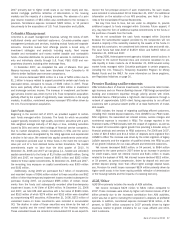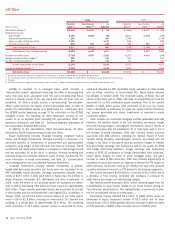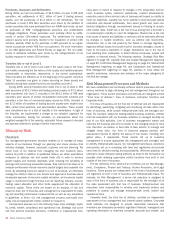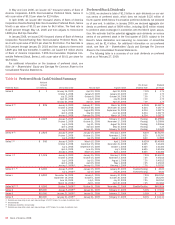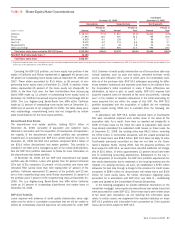Bank of America 2008 Annual Report Download - page 57
Download and view the complete annual report
Please find page 57 of the 2008 Bank of America annual report below. You can navigate through the pages in the report by either clicking on the pages listed below, or by using the keyword search tool below to find specific information within the annual report.employees’ actions are in compliance with corporate policies, standards,
procedures, and applicable laws and regulations.
We use various methods to manage risks at the line of business lev-
els and corporate-wide. Examples of these methods include planning and
forecasting, risk committees and forums, limits, models, and hedging
strategies. Planning and forecasting facilitates analysis of actual versus
planned results and provides an indication of unanticipated risk levels.
Generally, risk committees and forums are composed of lines of busi-
ness, risk management, treasury, compliance, legal and finance person-
nel, among others, who actively monitor performance against plan, limits,
potential issues, and introduction of new products. Limits, the amount of
exposure that may be taken in a product, relationship, region or industry,
seek to align corporate-wide risk goals with those of each line of business
and are part of our overall risk management process to help reduce the
volatility of market, credit and operational losses. Models are used to
estimate market value and net interest income sensitivity, and to esti-
mate expected and unexpected losses for each product and line of busi-
ness, where appropriate. Hedging strategies are used to manage the risk
of borrower or counterparty concentration risk and to manage market risk
in the portfolio.
The formal processes used to manage risk represent only one portion
of our overall risk management process. Corporate culture and the
actions of our associates are also critical to effective risk management.
Through our Code of Ethics, we set a high standard for our associates.
The Code of Ethics provides a framework for all of our associates to
conduct themselves with the highest integrity in the delivery of our prod-
ucts or services to our customers. We instill a risk-conscious culture
through communications, training, policies, procedures, and organiza-
tional roles and responsibilities. Additionally, we continue to strengthen
the linkage between the associate performance management process
and individual compensation to encourage associates to work toward
corporate-wide risk goals.
Oversight
The Board oversees the risk management of the Corporation through its
committees, management committees and the Chief Executive Officer.
The Board’s Audit Committee monitors (1) the effectiveness of our
internal controls, (2) the integrity of our Consolidated Financial State-
ments and (3) compliance with legal and regulatory requirements. In addi-
tion, the Audit Committee oversees the internal audit function and the
independent registered public accountant. The Board’s Asset Quality
Committee oversees credit and market risks and related topics that may
impact our assets and earnings. The Finance Committee, a management
committee, oversees the development and performance of the policies
and strategies for managing the strategic, credit, market, and operational
risks to our earnings and capital. The Asset Liability Committee (ALCO), a
subcommittee of the Finance Committee, oversees our policies and proc-
esses designed to assure sound market risk and balance sheet
management. The Global Markets Risk Committee (GRC) has been des-
ignated by ALCO as the primary governance authority for Global Markets
Risk Management. The Compliance and Operational Risk Committee, a
subcommittee of the Finance Committee, oversees our policies and proc-
esses designed to assure sound operational and compliance risk
management. The Credit Risk Committee (CRC), a subcommittee of the
Finance Committee, oversees and approves our adherence to sound
credit risk management policies and practices. Certain CRC approvals are
subject to the oversight of the Board’s Asset Quality Committee. The
Executive Management Team (i.e., Chief Executive Officer and select
executives of the management team) reviews our corporate strategies
and objectives, evaluates business performance, and reviews business
plans including economic capital allocations to the Corporation and lines
of business. Management continues to direct corporate-wide efforts to
address the Basel Committee on Banking Supervision’s new risk-based
capital standards (Basel II). The Audit Committee and Finance Committee
oversee management’s plans to comply with Basel II. For additional
information, see the Basel II discussion on page 59 and Note 15 – Regu-
latory Requirements and Restrictions to the Consolidated Financial
Statements.
Strategic Risk Management
Strategic risk is the risk that adverse business decisions, ineffective or
inappropriate business plans, or failure to respond to changes in the
competitive environment, business cycles, customer preferences, product
obsolescence, execution and/or other intrinsic risks of business will
impact our ability to meet our objectives. We use our planning process to
help manage strategic risk. A key component of the planning process
aligns strategies, goals, tactics and resources throughout the enterprise.
The process begins with the creation of a corporate-wide business plan
which incorporates an assessment of the strategic risks. This business
plan establishes the corporate strategic direction. The planning process
then cascades through the lines of business, creating business line plans
that are aligned with the Corporation’s strategic direction. At each level,
tactics and metrics are identified to measure success in achieving goals
and assure adherence to the plans. As part of this process, the lines of
business continuously evaluate the impact of changing market and busi-
ness conditions, and the overall risk in meeting objectives. See the
Compliance and Operational Risk Management section on page 92 for a
further description of this process. Corporate Audit in turn monitors, and
independently reviews and evaluates, the plans and measurement proc-
esses.
One of the key tools we use to manage strategic risk is economic
capital allocation. Through the economic capital allocation process we
effectively manage each line of business’s ability to take on risk. Review
and approval of business plans incorporate approval of economic capital
allocation, and economic capital usage is monitored through financial and
risk reporting. Economic capital allocation plans for the lines of business
are incorporated into the Corporation’s operating plan that is approved by
the Board on an annual basis.
Liquidity Risk and Capital Management
Liquidity Risk
Liquidity is the ongoing ability to accommodate liability maturities and
deposit withdrawals, fund asset growth and business operations, and
meet contractual obligations through unconstrained access to funding at
reasonable market rates. Liquidity management involves forecasting fund-
ing requirements and maintaining sufficient capacity to accommodate
fluctuations in asset and liability levels due to changes in our business
operations or unanticipated events. Sources of liquidity include deposits
and other customer-based funding, and wholesale market-based funding.
We manage liquidity at two levels. The first is the liquidity of the
parent company, which is the holding company that owns the banking and
nonbanking subsidiaries. The second is the liquidity of the banking sub-
sidiaries. The management of liquidity at both levels is essential because
the parent company and banking subsidiaries have different funding
needs and sources, and are subject to certain regulatory guidelines and
requirements. Through ALCO, the Finance Committee is responsible for
establishing our liquidity policy as well as approving operating and con-
tingency procedures, and monitoring liquidity on an ongoing basis. Corpo-
rate Treasury is responsible for planning and executing our funding
activities and strategy.
Bank of America 2008
55




